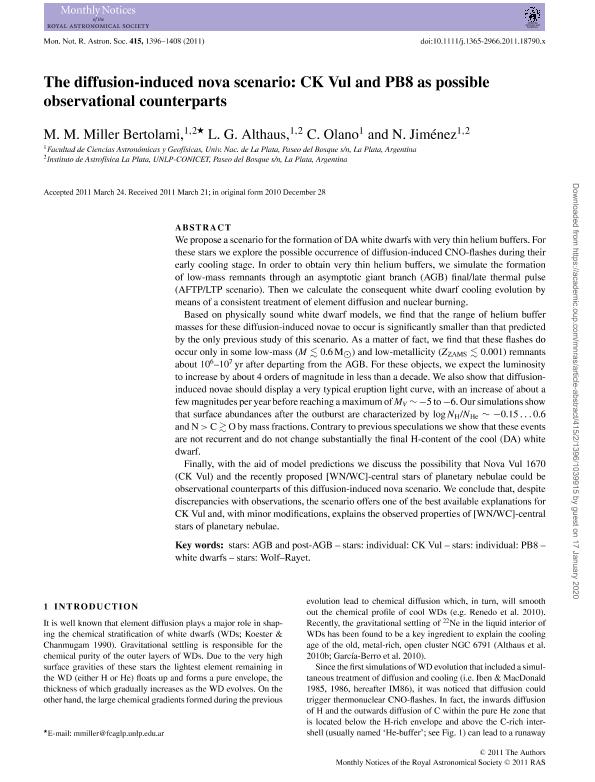Mostrar el registro sencillo del ítem
dc.contributor.author
Miller Bertolami, Marcelo Miguel

dc.contributor.author
Althaus, Leandro Gabriel

dc.contributor.author
Olano, Carlos Alberto

dc.contributor.author
Jiménez, N.
dc.date.available
2020-01-17T18:32:58Z
dc.date.issued
2011-08
dc.identifier.citation
Miller Bertolami, Marcelo Miguel; Althaus, Leandro Gabriel; Olano, Carlos Alberto; Jiménez, N.; The diffusion-induced nova scenario: CK Vul and PB8 as possible observational counterparts ; Wiley Blackwell Publishing, Inc; Monthly Notices of the Royal Astronomical Society; 415; 2; 8-2011; 1396-1408
dc.identifier.issn
0035-8711
dc.identifier.uri
http://hdl.handle.net/11336/95076
dc.description.abstract
We propose a scenario for the formation of DA white dwarfs with very thin helium buffers. For these stars we explore the possible occurrence of diffusion-induced CNO-flashes during their early cooling stage. In order to obtain very thin helium buffers, we simulate the formation of low-mass remnants through an asymptotic giant branch (AGB) final/late thermal pulse (AFTP/LTP scenario). Then we calculate the consequent white dwarf cooling evolution by means of a consistent treatment of element diffusion and nuclear burning. Based on physically sound white dwarf models, we find that the range of helium buffer masses for these diffusion-induced novae to occur is significantly smaller than that predicted by the only previous study of this scenario. As a matter of fact, we find that these flashes do occur only in some low-mass (M ≲ 0.6 M⊙) and low-metallicity (ZZAMS≲ 0.001) remnants about 106–107 yr after departing from the AGB. For these objects, we expect the luminosity to increase by about 4 orders of magnitude in less than a decade. We also show that diffusion-induced novae should display a very typical eruption light curve, with an increase of about a few magnitudes per year before reaching a maximum of MV ∼−5 to −6. Our simulations show that surface abundances after the outburst are characterized by log NH/NHe∼−0.15 … 0.6 and N > C ≳ O by mass fractions. Contrary to previous speculations we show that these events are not recurrent and do not change substantially the final H-content of the cool (DA) white dwarf. Finally, with the aid of model predictions we discuss the possibility that Nova Vul 1670 (CK Vul) and the recently proposed [WN/WC]-central stars of planetary nebulae could be observational counterparts of this diffusion-induced nova scenario. We conclude that, despite discrepancies with observations, the scenario offers one of the best available explanations for CK Vul and, with minor modifications, explains the observed properties of [WN/WC]-central stars of planetary nebulae.
dc.format
application/pdf
dc.language.iso
eng
dc.publisher
Wiley Blackwell Publishing, Inc

dc.rights
info:eu-repo/semantics/openAccess
dc.rights.uri
https://creativecommons.org/licenses/by-nc-sa/2.5/ar/
dc.subject
STARS: AGB AND POST-AGB
dc.subject
STARS: INDIVIDUAL: CK VUL
dc.subject
STARS: INDIVIDUAL: PB8
dc.subject
STARS: WOLF-RAYET
dc.subject
WHITE DWARFS
dc.subject.classification
Astronomía

dc.subject.classification
Ciencias Físicas

dc.subject.classification
CIENCIAS NATURALES Y EXACTAS

dc.title
The diffusion-induced nova scenario: CK Vul and PB8 as possible observational counterparts
dc.type
info:eu-repo/semantics/article
dc.type
info:ar-repo/semantics/artículo
dc.type
info:eu-repo/semantics/publishedVersion
dc.date.updated
2020-01-15T20:05:26Z
dc.journal.volume
415
dc.journal.number
2
dc.journal.pagination
1396-1408
dc.journal.pais
Reino Unido

dc.journal.ciudad
Londres
dc.description.fil
Fil: Miller Bertolami, Marcelo Miguel. Consejo Nacional de Investigaciones Científicas y Técnicas. Centro Científico Tecnológico Conicet - La Plata. Instituto de Astrofísica La Plata. Universidad Nacional de La Plata. Facultad de Ciencias Astronómicas y Geofísicas. Instituto de Astrofísica La Plata; Argentina
dc.description.fil
Fil: Althaus, Leandro Gabriel. Consejo Nacional de Investigaciones Científicas y Técnicas. Centro Científico Tecnológico Conicet - La Plata. Instituto de Astrofísica La Plata. Universidad Nacional de La Plata. Facultad de Ciencias Astronómicas y Geofísicas. Instituto de Astrofísica La Plata; Argentina
dc.description.fil
Fil: Olano, Carlos Alberto. Consejo Nacional de Investigaciones Científicas y Técnicas; Argentina. Universidad Nacional de La Plata. Facultad de Ciencias Astronómicas y Geofísicas; Argentina
dc.description.fil
Fil: Jiménez, N.. Consejo Nacional de Investigaciones Científicas y Técnicas. Centro Científico Tecnológico Conicet - La Plata. Instituto de Astrofísica La Plata. Universidad Nacional de La Plata. Facultad de Ciencias Astronómicas y Geofísicas. Instituto de Astrofísica La Plata; Argentina
dc.journal.title
Monthly Notices of the Royal Astronomical Society

dc.relation.alternativeid
info:eu-repo/semantics/altIdentifier/doi/http://dx.doi.org/10.1111/j.1365-2966.2011.18790.x
dc.relation.alternativeid
info:eu-repo/semantics/altIdentifier/url/https://academic.oup.com/mnras/article/415/2/1396/1039915
Archivos asociados
